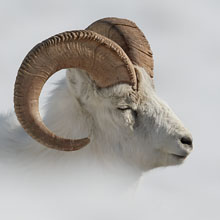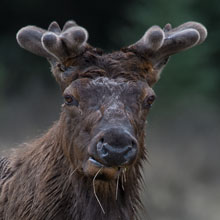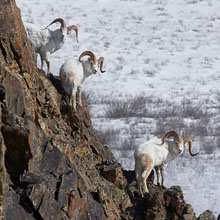Availability: Undetermined - Enquiries?
In the Field
Out with the Old... SE British Columbia, Canada. April 29, 2016.
We commonly think of spring as a time of re-birth and growth, and those of us living in more northerly climes look forward to it for months. To me this bull elk portrait just screams "spring"...he's cast off last year's antlers and - as his lumpy and velvety crown clearly proclaims - he's begun growing the 2016 edition. And, as you can tell from his patchy fur, he's begun shedding his heavier winter coat in favor of his sleeker summer attire! At this time of the year the elk aren't really in their most attractive phase (and someone might think they look almost goofy!), but they do sure do exhibit some good ol' interesting character when you catch them like this and without their Sunday Best on!
I captured this image just a few days after acquiring my Nikon D500 - Nikon's first serious venture BACK into the cropped (DX) sensor market. I decided to kinda "push things" a little with this shot and see how the AF system (prior to any AF tuning) handled some long focal lengths - I paired up my Nikkor 400mm f2.8E VR lens with the 2x (TC-20EIII) teleconverter...giving me a total focal length (including crop factor) of 1200mm. In my view the camera did OK!
When I was capturing this shot ONE aspect of the AF system was very clearly illustrated to me - the trade-off between full viewfinder coverage of selectable focus points and LARGE focus points. Most viewers probably know that the D500 has a very similar (if not identical) AF system to the D5. So that means 55 selectable focus points, but on a smaller sensor. This translates into amazing complete coverage of the viewfinder by the selectable focus points, which many will absolutely love. The outermost brackets almost TOUCH the lateral sides of the image!
But what's the trade-off? Well...in covering almost the full viewfinder, each of those 55 selectable points takes up relatively more "real estate" in the viewfinder, i.e., they are relatively larger than they are on the D5. With this shot (and you're looking at the full-framed shot) I wanted to precisely place the focus point about 1/3 the way up the snout (or rostrum) just past the dark fur above the nose pad. BUT, on the D500 the focus point was too large to precisely occupy JUST that space and the bracket overlapped on the dark fur on the nose and a little higher up on the snout than I wanted. And one "toggle" of the focus point up moved it further back than I wanted (almost between the eyes). Is losing a little of the ability to precisely position the focus point a big problem? Most of the time - no (and as you can see it certainly didn't really hurt me much here). And I think most will gladly live with this trade-off if it means almost full viewfinder coverage by the focus points (you won't be needing to "focus, focus-lock, and re-compose" much with the D500!).
Here's a higher resolution (2400 pixel) version of this decidely scruffy elk for those wanting to see it a little better:
• Out with the Old... Download 2400 pixel image (JPEG: 1.6 MB)
ADDITIONAL NOTES:
1. This image - in all resolutions - is protected by copyright. I'm fine with personal uses of them (including use as desktop backgrounds or screensavers on your own computer), but unauthorized commercial use of the image is prohibited by law. Thanks in advance for respecting my copyright!
2. Like all wildlife photographs on this website, this image was captured following the strict ethical guidelines described in The Wildlife FIRST! Principles of Photographer Conduct. I encourage all wildlife photographers to always put the welfare of their subjects above the value of their photographs.
Behind the Camera
Out with the Old... SE British Columbia, Canada. April 29, 2016.
Digital Capture; Compressed RAW (NEF) 14-bit format; ISO 720.
Nikon D500 paired with Nikkor 400mm f2.8E VR plus TC-20EIII (2x) teleconverter, for a total EFL of 1200mm. Hand-held. VR on and in "Sport" mode.
1/500s @ f9; No compensation from "recommended" matrix-metered exposure setting.
At the Computer
Out with the Old... SE British Columbia, Canada. April 29, 2016.
RAW Conversion to 16-bit TIFF using Lightroom CC 2015.5 (ACR 9.5). Four raw variants (different versions of a single raw capture) processed, with the variants differing in exposure settings (0.85 stop total difference between the variants) and shadow recovery settings.
Further digital corrections on resulting 16-bit TIFF files using Adobe's Photoshop CC 2015. Photoshop adjustments included compositing (blending) of the four output files from the raw converter, minor tweaks to colour saturation, and final selective sharpening for web output.
Conservation
Out with the Old... SE British Columbia, Canada. April 29, 2016.
Species Status in Canada*: This species is not designated as at risk.
Elk (Cervus elaphus) are the second largest member of the deer family in British Columbia (and in North America). Rocky Mountain Elk (of the Cervus elaphus nelsoni subspecies) like to forage in a mix of grasslands and shrublands or in mixed coifer and deciduous forests. Elk are highly social mammals and their herding behaviour is thought to be an anti-predator strategy - with more eyes watching each individual Elk can spend a greater proportion of their time foraging. In British Columbia wolves are the main predators of all age and sex classes of Elk. Cougars will also prey on Elk of all ages, and both Grizzly and Black Bears prey primarily on the young of the year.
Elk are now common again in much of western North America - in fact Elk now are found in more habitats and in higher numbers (approaching a million animals) than any other time since 1900. The future on Elk populations in North America seems secure.
*as determined by COSEWIC: The Committee on the Status of Endangered Wildlife in Canada

























